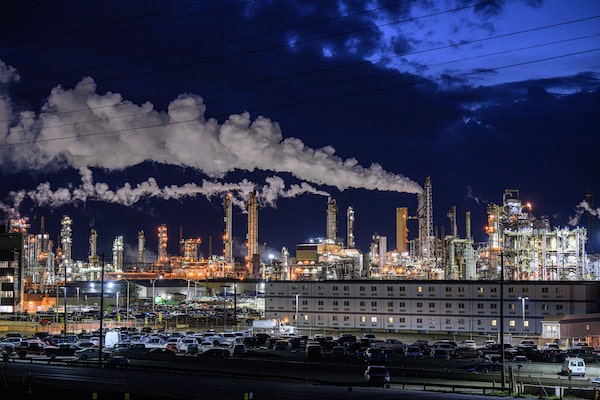
The Syncrude oil sands mining facility near Fort McKay, Alta. on Sept. 7, 2022.ED JONES/Getty Images
Ottawa has forced Canada’s oil and gas producers into a moment of truth, with the long-awaited release of its plan for a cap on the industry’s greenhouse-gas emissions.
It’s a test that fossil-fuel companies knew was coming since Prime Minister Justin Trudeau first promised it more than two years ago.
And the framework finally laid out on Thursday, which indicates that the regulation will require sectoral emissions to fall 20 to 23 per cent from 2019 levels by 2030 – or 35 to 38 per cent to avoid having to buy offsets or pay into a decarbonization fund – is less onerous than the government had earlier signalled.
That didn’t exactly result in the announcement being greeted with open arms by the sector’s representatives.
Pathways Alliance, representing oil-sands giants, was muted in its response, saying in a statement that it will “take the necessary time” to examine the framework’s implications. Other industry groups such as the Explorers and Producers Association of Canada and the Canadian Association of Petroleum Producers, though, treated it as an affront that will cost investments and jobs.
But the response that will really matter will be from the companies themselves, whose leaders were mostly keeping their heads down on Thursday.
And it will be measured not in words, nor in vague long-term plans, but in how they allocate capital within the next couple of years.
The industry itself has repeatedly made the case that time is extremely tight to be able to meet ambitious emissions-reduction targets this decade, given the long lead times for related projects – especially involving the carbon capture technology to which it has largely pinned its sustainability hopes.
But it has mostly held off on actually making those investments, while demanding new subsidies from the federal and provincial governments.
It’s far from a given that companies will be compelled to move more swiftly by the outline of an emissions cap that Ottawa only intends to put into law in 2025 (and that will only really take effect in 2026). The possibility of it being scrapped by a Conservative government after the next election, if even in place by then, could justify continuing to rag the puck; likewise the uncertain outcome of an inevitable constitutional challenge by the governments of oil-producing provinces.
But if the sector doesn’t start moving more swiftly toward decarbonization, it will also be calling its own bluff.
For years, Canadian oil and gas producers have been pushing the idea that, even as countries shift to non-emitting (mostly electric) fuel sources, they will be able to compete for remaining fossil-fuel demand by becoming less emissions-intensive than their international competition.
That’s very much the premise in which Environment Minister Steven Guilbeault and Natural Resources Minister Jonathan Wilkinson couched Thursday’s announcement. They played up the economic benefits of decarbonization, as much as the obvious need to tackle Canada’s highest-emitting sector to make good on the country’s broader international climate commitments.
Their government’s willingness to compromise, after giving the impression that industry would be expected to cut emissions by more than 40 per cent from 2019 levels, has also brought that requirement much closer to what oil and gas executives and representatives have previously indicated is feasible without production cuts.
Partly, that’s a matter of trying to stay within its constitutional bounds, which production limits would violate.
But it also fits with the economic argument. Ottawa contends that companies will be able to meet their obligations and boost competitiveness by investing in new technologies that have their own job-creating possibilities – mostly carbon capture in the oil sands, and measures to reduce methane leaks from conventional oil and natural gas.
At the same time, there are now more subsidies for those investments than ever before. Ottawa has aligned its roll-out of the emissions-cap framework with the finalization and implementation of a tax credit covering up to 50 per cent of the costs of carbon-capture projects.
Alberta has announced a provincial carbon-capture incentive that could cover another 12 per cent of those costs, and the new Canada Growth Fund intends to spend some of its $15-billion budget financing the sector’s clean-tech investments, adding to loan and grant programs in place.
There is even an incentivizing aspect to the regulatory plans laid out on Thursday, since the cap-and-trade model would allow companies that exceed carbon-cutting requirements to sell credits.
The industry can reasonably argue that other financial supports would still help. That most notably includes carbon contracts for difference, which would further guarantee companies value for each abated tonne of emissions, once major decarbonization projects are operational.
Still, it finally has clarity on the carrot-and-stick combination that Ottawa intends to deploy.
That should make it harder to argue that it’s being held up by policy uncertainty. And it could make it somewhat easier to argue to shareholders, to whom companies have recently been returning record profits, that more money needs to go into transforming operations, as a matter of both opportunity and compliance.
It represents a chance to break from what has thus far been a frustrating path toward 2030, for which not just the sector has borne responsibility, but also the federal government.
Ottawa has been needlessly slow to provide clarity on both its incentives (particularly the carbon-capture tax credit) and its regulatory plans. Mr. Trudeau initially promised the emissions cap, during an election campaign, without any evident idea of what form it would take.
There is a strong argument, quietly acknowledged even by some environmental advocates, that it would have been more efficient to strengthen the existing industrial carbon-pricing system rather than add a whole other sector-specific regulatory regime atop it.
But there is also an argument for taking the underlying optimism of Thursday’s announcement at face value, for a moment at least.
In becoming the first government of a major oil producer to try to curb emissions this way, Ottawa has ostensibly taken the domestic fossil-fuel sector at its word that it’s both willing and able to extract oil and gas more sustainably than its international competition.
The ball is now in industry’s court.
 Adam Radwanski
Adam Radwanski